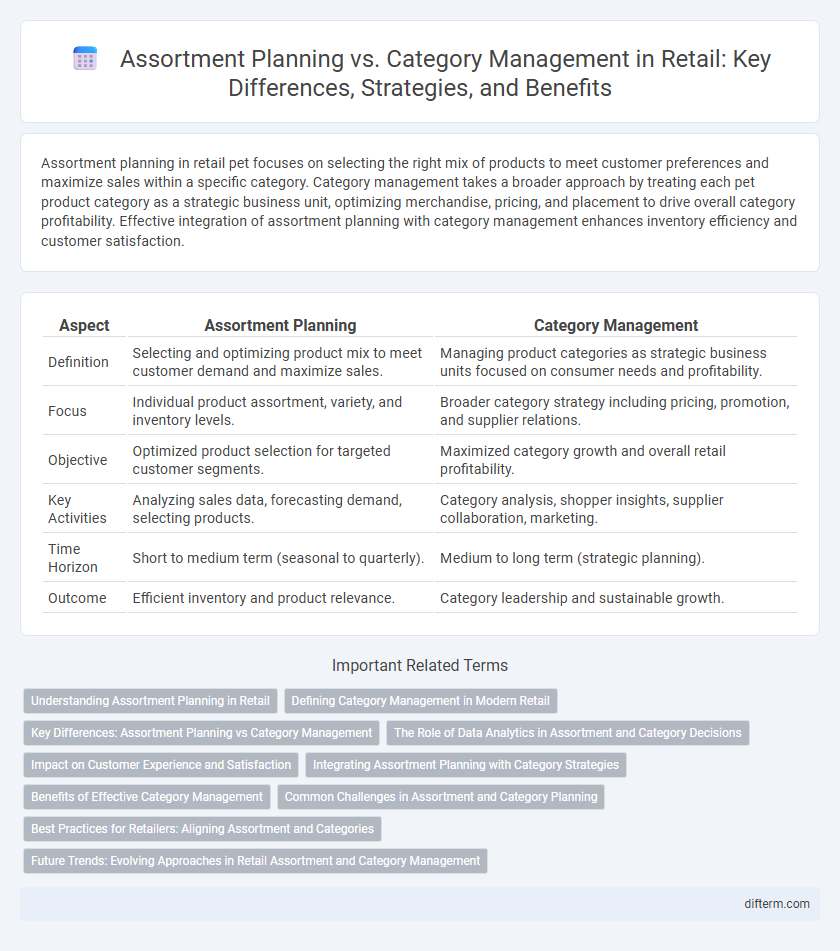Assortment planning in retail pet focuses on selecting the right mix of products to meet customer preferences and maximize sales within a specific category. Category management takes a broader approach by treating each pet product category as a strategic business unit, optimizing merchandise, pricing, and placement to drive overall category profitability. Effective integration of assortment planning with category management enhances inventory efficiency and customer satisfaction.
Table of Comparison
| Aspect | Assortment Planning | Category Management |
|---|---|---|
| Definition | Selecting and optimizing product mix to meet customer demand and maximize sales. | Managing product categories as strategic business units focused on consumer needs and profitability. |
| Focus | Individual product assortment, variety, and inventory levels. | Broader category strategy including pricing, promotion, and supplier relations. |
| Objective | Optimized product selection for targeted customer segments. | Maximized category growth and overall retail profitability. |
| Key Activities | Analyzing sales data, forecasting demand, selecting products. | Category analysis, shopper insights, supplier collaboration, marketing. |
| Time Horizon | Short to medium term (seasonal to quarterly). | Medium to long term (strategic planning). |
| Outcome | Efficient inventory and product relevance. | Category leadership and sustainable growth. |
Understanding Assortment Planning in Retail
Assortment planning in retail involves strategically selecting and offering a range of products that meet consumer demand while maximizing sales and profitability. This process requires analyzing customer preferences, sales data, and market trends to optimize product mix and inventory levels. Effective assortment planning enhances store performance by balancing variety, availability, and shelf space utilization.
Defining Category Management in Modern Retail
Category management in modern retail involves strategically grouping products into coherent categories to optimize sales and enhance customer experience. It emphasizes understanding consumer behavior, market trends, and supplier collaboration to tailor assortment, pricing, and promotions effectively. This approach drives profitability by aligning inventory decisions with targeted category performance and shopper preferences.
Key Differences: Assortment Planning vs Category Management
Assortment planning focuses on selecting the optimal mix of products to meet customer demand and maximize sales within a specific category, using data-driven insights and trend analysis. Category management involves a broader strategic approach, overseeing entire product categories to enhance overall profitability, vendor relationships, and shelf space allocation. While assortment planning emphasizes product selection, category management integrates pricing, promotion, and inventory decisions to achieve business goals.
The Role of Data Analytics in Assortment and Category Decisions
Data analytics drives precision in assortment planning by identifying customer preferences and optimizing product mix based on sales trends and inventory turnover. In category management, analytics enhance supplier performance evaluation, pricing strategies, and promotion effectiveness to maximize category profitability. Leveraging real-time data enables retailers to make dynamic, demand-driven decisions that align assortment and category goals with changing market conditions.
Impact on Customer Experience and Satisfaction
Assortment planning enhances customer experience by ensuring product availability and variety tailored to specific shopper preferences, leading to increased satisfaction and loyalty. Category management improves satisfaction through strategic product placement and pricing, optimizing the shopping journey and making it easier for customers to find and compare items. Both practices drive higher customer engagement by aligning inventory decisions with consumer demands and behavioral insights.
Integrating Assortment Planning with Category Strategies
Integrating assortment planning with category management enhances retail performance by aligning product selection with strategic category goals, optimizing inventory turnover and profitability. Effective integration leverages data analytics to tailor assortments that meet consumer demand while supporting category-specific objectives such as margin improvement and shopper experience. This synergy enables retailers to drive sales growth and maintain competitive advantage through precise assortment decisions informed by comprehensive category insights.
Benefits of Effective Category Management
Effective category management improves retail profitability by aligning product assortments with consumer demand and market trends, ensuring optimal inventory levels and reducing stockouts. Enhanced shopper experience results from well-organized categories tailored to customer preferences, increasing basket size and loyalty. Data-driven insights enable strategic vendor negotiations and targeted promotions, maximizing sales and minimizing markdowns.
Common Challenges in Assortment and Category Planning
Retailers often face challenges in assortment planning and category management such as balancing consumer demand with inventory costs, managing supplier relationships, and accurately forecasting sales trends. Difficulty in integrating data from multiple sources can lead to misalignment between assortment variety and category objectives, impacting overall profitability. Effective use of analytics and collaborative planning tools is essential to address these complexities and optimize product mix decisions.
Best Practices for Retailers: Aligning Assortment and Categories
Effective assortment planning and category management are critical for optimizing retail performance by aligning product selection with shopper preferences and category roles. Retailers should leverage data analytics to ensure assortment depth and breadth meet local demand while maintaining category profitability through strategic product placement and promotional tactics. Integrating real-time sales data and customer insights enhances decision-making, driving inventory efficiency and improving overall category growth.
Future Trends: Evolving Approaches in Retail Assortment and Category Management
Future trends in retail assortment planning and category management emphasize data-driven decision-making powered by AI and machine learning, enabling retailers to predict consumer preferences with greater accuracy. Integration of omnichannel strategies ensures seamless inventory alignment across physical and digital platforms, enhancing customer experience and operational efficiency. Sustainability and personalized assortment approaches are gaining momentum, reflecting shifting consumer values and driving competitive differentiation.
Assortment Planning vs Category Management Infographic

 difterm.com
difterm.com